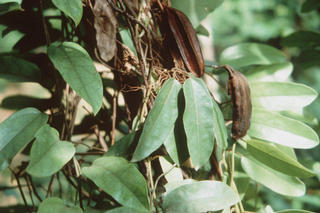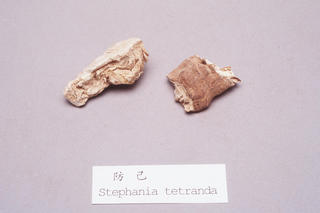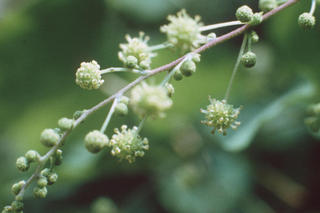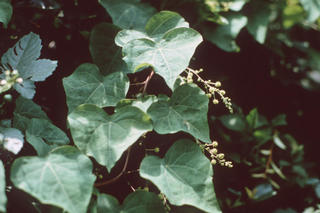Aristolochia fangchi
Contents
Nomenclature
Other Names:
Historical Use of Aristolochia fangchi
Aristolochia fangchi in Traditional Chinese Medicine
Background
Chinese Name (pinyin): Guanfangji
Chinese Name :
Common Name :Southern Fangchi Root
Specific Name : Radix aristolochiae fangchi
Scientific Name:
Collection : The drug is collected in autumn and winter, wash clean, cut into section, split the thick root longitudinally into two valves and dried.
Description : Cylindrical or semi-cylindrical, slightly curved, 6 - 18cm long, 1.5 - 4.5 cm in diameter. Externally greyish brown, rough, longitudinally wrinkled, peeled ones yellowish, marked with traces of knife scrape. Texture heavy and compact. Uneasily broken, fracture starchy, exhibiting alternately greyish brown and whitish radial lines. Odourless, taste, bitter.
Identification : 1.Transverse section: Cork consisting of 10 - 15 layers of cells. Phelloderm of 3 - 5 layers of cells. A continuous ring of stone cells associated with phelloderm, more layers of parenchymatous cells beneath. Phloem rays broad, sieve tube groups collapsed, a few stone cells scattered less distinct. Xylem rays 20 - 30 or more cells in width, vessels relatively large, 45 - 220µm in diameter, wood fibres abopuit 20 µm in diameter in bundle accompanied by the vessels with rather thickened walls. Parenchymatous cells filled with starch granules, sometimes containing a few clusters of calcium oxalate.2.To 2 g of the powder add 10 ml of methanol, heat under reflux for 20 minutes and filter. To 1 ml of the filtrate add 5 drops of 0.4% 2, 4-dinitrophenylhydrazine solution, an orange red turbidity or precipitate is produced. Evaporate 1 ml of the filtrate to dryness. Dissolve the residue in 1 ml of water by gentle `heat, add 1 ml of alkaline cupric tartrate TS and heat for 10 minutes, a brick red colour precipitate is produced.3.To 3g of the powder add 50 ml of ethanol, heat under reflux on a water bath for 1 hour, filter. Evaporate the filtrate to dryness, dissolve the residue in 5 ml of ethanol as the test solution. Produce a solution of Radix Aristolochiae Fangchi reference drug in the same manner as the reference drug solution. To aristolochic acid CRS add a mixture of methanol acetone (9:1), ultrasonicate for 15 minutes to produce a solution containing 0.2 mg per ml as the reference solution. Carry out the method for thin layer chromatography (Appendix Vl B) using silica gel G as the coating substancee and the upper layer of the mixture of toluene-ethyl acetate-water-formic acid (20:10:1:1) as the mobile phase. Apply bandwise 3 µl of each of the three solutions to the plate. After developing and removal of the plate, dry it in the air and examine under sunlight and ultra violet light (365 nm). The bands in the chromatogram obtained with the test solution correspond in position and colour to those in the chromatogram obtained with reference drug solution and a band due to aristolochic acid on the chromatogram obtain with test solution corresponds to that on the chromatogram obtained with the reference solution.Assay: To 5g of the coarse powder, accurately weighed in a Soxhlet's extractor, add 60 ml of methanol, heat under reflux on a water bath until the solution is colorless. Concentrate the solution to 20 ml on a water bath, transfer the solution to a 25 ml volumetric flask, wash with quantity of methanol for several times, filter the solution in the same volumetric flask and dilute to volume with methanol. To Aristolochic acid CRS, weigh accurately add a mixture of methanol acetone (9:1), ultrasonicate for 15 minutes to produce a solution. Carry out the method for thin layer chromatography (Appendix Vl B) using silica gel GF254 containing sodium carboxymethylcellulose as the coating substance and the upper layer of toluene-ethyl acetate-water-formic acid (20:5:1:1 keep in a refregerator over night before use) as the mobile phase. Apply bandwise 3 µl of each of the three solutions to the plate. After developing and removal of the plate, dry it in the air and examine under sun light and ultra violet light (365 nm). The bands in the chromatogram obtained with the test solution correspond in position and color to those in the chromatogram obtained with the reference drug solution and a band use to aristolochic acid on the chromatogram obtained with test solution correspond to that on the chromatogram obtained with the reference solution.Assay: To 5 g of the coarse powder, accurately weighed in a Soxhlet's extractor, add 60 ml of methanol, heat under reflux on a water bath until the solution is colorless. Concentrate the solution to 20 ml on a water bath, transfer the solution to a 25 ml volumetric flask, wash with quantity of methanol for several times, filter the solution in the same volumetric flask and dilute to volume with methanol. To aristolochic acid CRS, weighed accurately. Add a mixture of methanol-acetone (9:1), ultrasonicate for 15 minutes to produce a solution containing 0.2 mg per ml as the reference solution. Carry out the method for thin layer chromatography (Appendix Vl B) using silica gel GF254 containing sodium carboxymethylcellulose as the coating substance and the upper layer of toluene-ethyl acetate-water-formic acid (20:5:1:1 keep in refrigerator overnight before use) as the mobile phase. Apply separately 2 µl of the test solution and 1 µl of the reference solution to the plate. After developing and removal of the plate, dry it in the air. Carry out the method for thin layer chromatographic scanning method) (Appendix Vl B), scan at wavelengths of Ûs= 318nm and ÛR=350nm, measure the integration ebsorbance values both of the test solution and the reference solution respectively. Calculate the content. It contains not less than 0.1% of aristolochic acid (C30H48O3) on the dried basis
Processing : Eliminate foreign matter and the rugged outer layers, soak briefly, wash clean, soften thoroughly, cut into thick slices and dry.
Action : To dispel wind, relieve pain, reduce heat and induce diuresis.
Indication : general aching caused by damp-heat, rheumatic arthralgia, edema of the lower extremities with oliguria
Precautions :
Dosage : 4.5 to 9 g.
Storage : Preserve in a dry place, protected from mould and moth.
Nomenclature
Other Names:
Historical Use of Aristolochia fangchi
Aristolochia fangchi in Traditional Chinese Medicine
Background
Hanfangji ºº·À¼º
Mufangji ľ·À¼º
Chinese Name (pinyin): Fangji
Chinese Name :
Common Name :Tetrandra Root
Specific Name : Radix stephaniae tetrandrae
Scientific Name:
Collection : The drug is collected in autumn, wash clean, removed from outer coarse bark, half dried in the sun, cut into section, the large one is cut longitudinally and dried.
Description : Irregular cylindrical, semi cylindrical or lump shaped, mostly tortous, 5 - 10 cm long, 1 - 5 cm in diameter. Externally greyish yellopw, usually exhibiting deeply depressed transverse grooves appearing as knotty knobby at the curved part. Texture heavy and compact, fracture even, greyish white, starchy, sparsely. Odour slight, taste bitter.
Identification : 1.Transverse section: Remaining cork sometimes visible. Cortex scattered with stone cells groups, usually arranged tangentially, phloem relatively broad. Cambium in a ring. The greater part occupied by xylem rays wide. Vessels rare, radially arranged, accompanied by wood fibres. Parenchymatous cells filled with starch granules and a few minute rod shape crystals of calcium oxalate.2.Heat about 2 g of the powder with 20 ml of sulfuric acid solution (0.5 mol/L) for 10 minutes and filter, adjust the filtrate to pH 9 By adding ammonia TS. Transfer to a separator and extract with 25 ml of benzene. Evaporate 5 ml of benzene extract to dryness and add several drops of molybdo-sulfuric acid TS to the residue, a violet color is produced which gradually becomes a green to dirty green colour and deepens on standing.3.Heat under reflux 1 g of the powder with 15 ml of ethanol for 1 hour, cool, filter and evaporate the filtrate to dryness. Dissolve the residue inb 5 ml of ethanol as the test solution. Dissolve tetrandrine CRS and fangchinoline CRS in chloroform to produce a mixture containing 1 mg of each per ml as the reference solution. Carry out the method for thin layer chromatography (Appendix l B) Using silica gel G as the coating substance and chloroform acetone-methanol (6:1:1) as the mobile phase. Apply separately to the plate 5µl of each of the two solutions. After developing and removal of the plate, dry it in the air and spray with dilute potassium iodobismuthate TS. The spots due to tetrandine and fangchinoline in the chromatogram obtained with the test solution correspond in position and colour with the spots in the chromatogram obtained with the reference solution.Assay: Weigh accurately about 1 g of the powder (through no. 3 sieve) previously dried at 80ºC for 4 hours to a Soxhlet's extractor, add 6 drops of concentrated ammonia solution, stand for 1 hour then add a quantity of chloroform and heat under reflux on a water bath for about 6 hours. After recovering of chloroform on a water bath, cool and dissolve the residue in absolute ethanol, transfer to a 2 ml volumetric flask, add absolute ethanol to volumn, mix well as the test solution. Dissolve tetrandine CRS in chloroform to produce a solution containing 2 mg of per ml as the reference solution. Carry out the method for thin layer chromatography (Appendix Vl B), using silica gel G as the coating substance and chloroform-acetone-methanol-concentrated ammonia (20:3:2:0.1) as the mobile phase. Apply accurately in strip to the plate 100 µl of the test solution and 10 µl of the test solution and 10 µl of the reference solution beside. After developing and removal of the plate, expose immediately under ultra violet light (365 nm) for about 10 minutes. Scrape off the strip of the test preparation corresponding in position with the reference spot, and scrape off equal area of silica gel G on the same plate as a blank. Packed to 2 column (0.7 cm x 10 cm). Carry out the method for column chromatography (Appendix Vl C), elute with 30 ml of methanol. Collect the eluate in an evaporating dish and evaporate to dryness on a water bath. Allow to cool, add accurately 10 ml of hydrochloric acid solution (0.1 mol/L) and dissolve the residue completely. Carry out the method for spectrophotometry (Appendix V A), measure the absorbance of the resulting solution at 280 nm. Calculate the content of C38H42N2O6, taking 113 as the value of A(1%, 1 cm). It contains not less than 0.7% of tetrandine (C38H42N2O6), calculate on the dried drug at 80ºC for 4 hours.
Processing : Eliminate foreign matter, soak briefly, wash clean, soften thoroughly, cut into thick slices and dry. Occurring in subrounded or broken thick slices, edges rather dark in colour, cut surface greyish white, starchy with sparse radial striations. Odour slight, taste bitter.
Action : To cause diuresis and to relieve rheumatic conditions.
Indication :
Precautions :
Dosage : 4.5 to 9 g.
Storage : Preserve in a dry place, protected from mould nd moth.
Synonymns for Aristolochia fangchi
Patent Medicines and Medicines with Multiple Ingredients that include Aristolochia fangchi
Pharmaceutical Information
Chemical Constituents
Evidence or the Use of Aristolochia fangchi in the Treatment of Epilepesy
Basic Science
Animal Studies
Cohort, Case-Control and Non-Randomized Trials
Randomized Controlled Trials
Meta-Analysis
1st Five Results: pubmed search
Qingqun Cai, Shiyin Feng, Xiasheng Zheng
##Title##
Genome: 2024, 67(3);90-98
[PubMed:38091583]
[WorldCat.org]
[DOI]
(I p)
Ya Jin Luo, Shi Dong Ni, Qiang Jiang, Bo Gao Huang, Yan Liu, Yu Song Huang
##Title##
PhytoKeys: 2020, 153;49-61
[PubMed:32765180]
[WorldCat.org]
[DOI]
(P e)
Jinfeng Chen, Qian Zhao, Dandan Si, Anzheng Nie, Yuanyuan Wang, Zhifen Deng, Yibo Wen, Fengmei Chen, Lei Zhang, Bowen Dong, Jinghua Yang
Comprehensive profiling of Stephania tetrandra (Fangji) by stepwise DFI and NL-dependent structure annotation algorithm-based UHPLC-Q-TOF-MS and direct authentication by LMJ-HRMS.
J Pharm Biomed Anal: 2020, 185;113225
[PubMed:32163850]
[WorldCat.org]
[DOI]
(I p)
Bojan Jelaković, Živka Dika, Volker M Arlt, Marie Stiborova, Nikola M Pavlović, Jovan Nikolić, Jean-Marie Colet, Jean-Louis Vanherweghem, Joëlle L Nortier
Balkan Endemic Nephropathy and the Causative Role of Aristolochic Acid.
Semin Nephrol: 2019, 39(3);284-296
[PubMed:31054628]
[WorldCat.org]
[DOI]
(I p)
Yuan Cui, Jiayin Han, Juan Ren, Huiming Chen, Baoliang Xu, Naining Song, Haishan Li, Aihua Liang, Guolin Shen
Untargeted LC-MS-based metabonomics revealed that aristolochic acid I induces testicular toxicity by inhibiting amino acids metabolism, glucose metabolism, β-oxidation of fatty acids and the TCA cycle in male mice.
Toxicol Appl Pharmacol: 2019, 373;26-38
[PubMed:31009690]
[WorldCat.org]
[DOI]
(I p)



